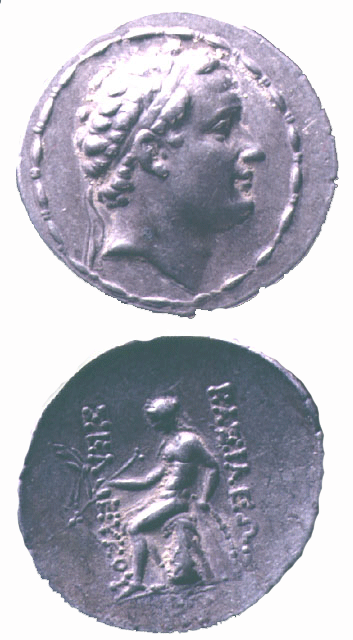Seleukid Silver Tetradrachm of King Seleukos IV, 187 BCE - 175 CE
Silver
C.141
Obverse: Portrait of the King Wearing a Diadem Facing Right Reverse: Apollo Nude Seated on Omphalos, Holding Arrow and Bo The Seleukid Kingdom was established by Seleukos I, one of...
Obverse: Portrait of the King Wearing a Diadem Facing Right
Reverse: Apollo Nude Seated on Omphalos, Holding Arrow and Bo
The Seleukid Kingdom was established by Seleukos I, one of the generals of Alexander the Great, following the death of Alexander and the division of his empire. At its peak under Seleukos I and Antiochus I, the Seleucid Kingdom comprised almost the whole of the conquests of Alexander with the exception of Egypt. Elder son of Antiochus III the Great, Seleukos IV had a lackluster reign that witnessed the independence of Parthia and Bactria. Besides losing these territories that his father had conquered, he was also forced to pay a war-indemnity charge to the Romans. However, he governed the territory that left within his control well until he was finally murdered by his minister Heliodoros.
How many hands have touched a coin in your pocket or your purse? What eras and lands have the coin traversed on its journey into our possession? As we reach into our pockets to pull out some change, we rarely hesitate to think of who touched the coin before us, or where the coin will venture to after us. More than money, coins are a symbol of the state that struck them, of a specific time and place, whether currency in the age we live or an artifact of a long forgotten empire. This ancient coin is more than an artifact; it is a memorial to a lost kingdom passed from the hands of civilization to civilization, from generation to generation.
Reverse: Apollo Nude Seated on Omphalos, Holding Arrow and Bo
The Seleukid Kingdom was established by Seleukos I, one of the generals of Alexander the Great, following the death of Alexander and the division of his empire. At its peak under Seleukos I and Antiochus I, the Seleucid Kingdom comprised almost the whole of the conquests of Alexander with the exception of Egypt. Elder son of Antiochus III the Great, Seleukos IV had a lackluster reign that witnessed the independence of Parthia and Bactria. Besides losing these territories that his father had conquered, he was also forced to pay a war-indemnity charge to the Romans. However, he governed the territory that left within his control well until he was finally murdered by his minister Heliodoros.
How many hands have touched a coin in your pocket or your purse? What eras and lands have the coin traversed on its journey into our possession? As we reach into our pockets to pull out some change, we rarely hesitate to think of who touched the coin before us, or where the coin will venture to after us. More than money, coins are a symbol of the state that struck them, of a specific time and place, whether currency in the age we live or an artifact of a long forgotten empire. This ancient coin is more than an artifact; it is a memorial to a lost kingdom passed from the hands of civilization to civilization, from generation to generation.



